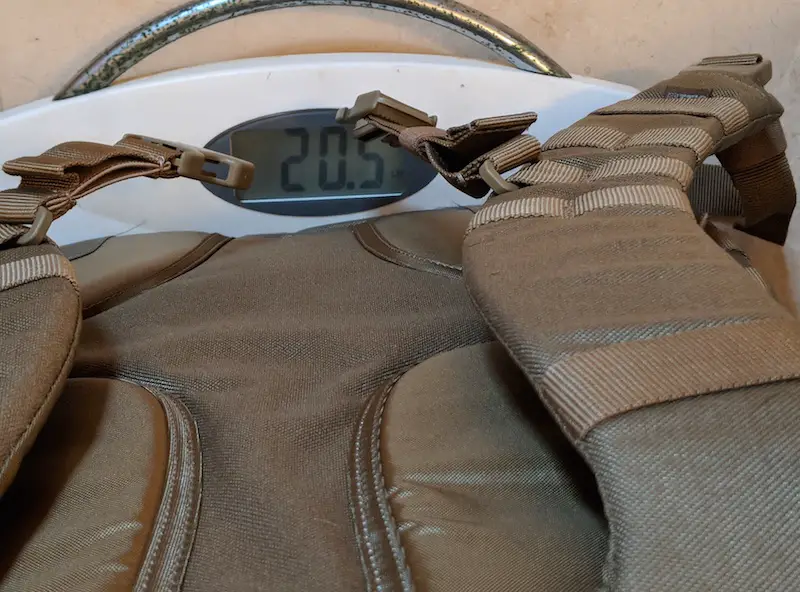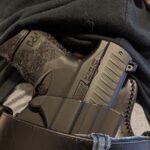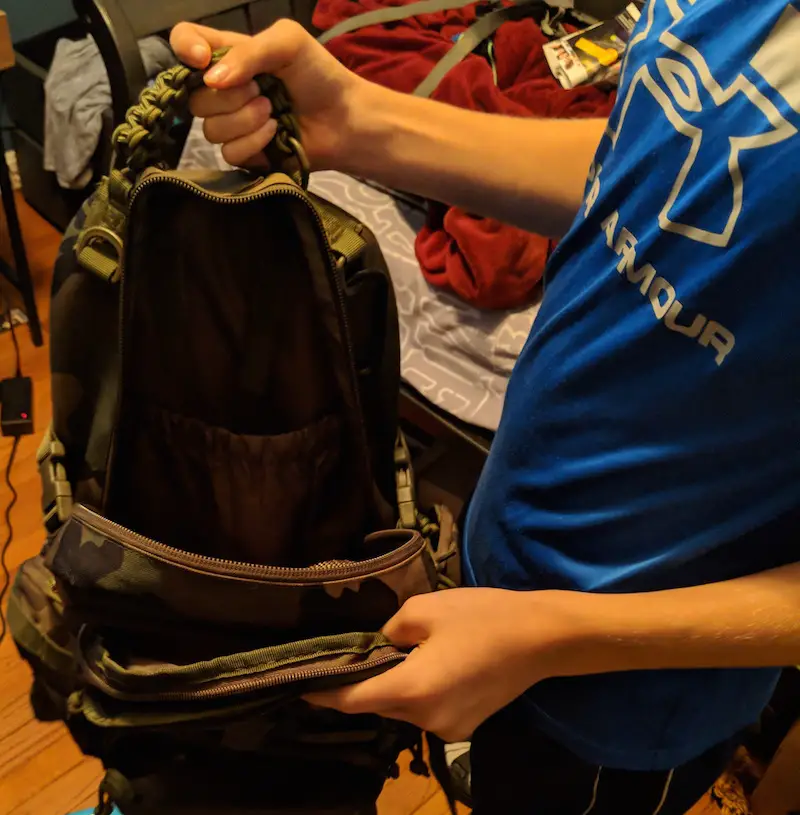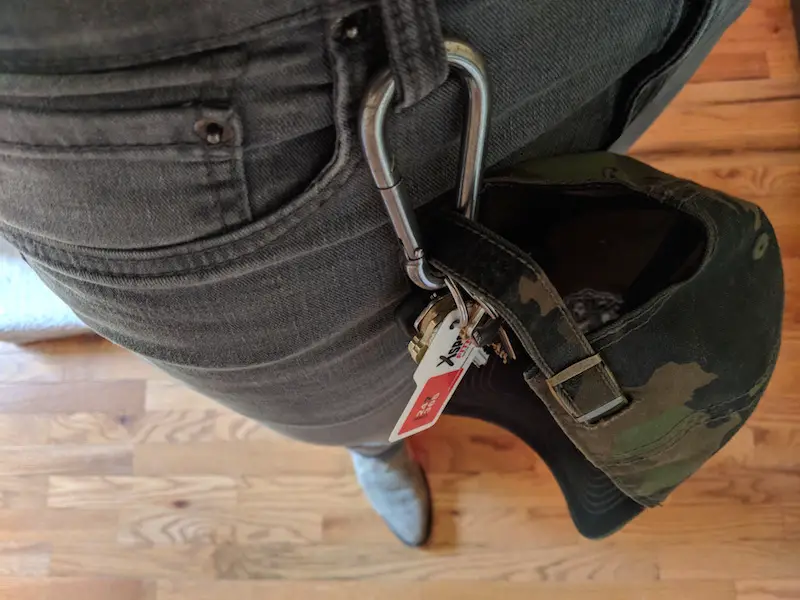My kit has transformed over the years, as a matter of fact, it changes almost weekly. Depending on what I’m doing, where I’m going, and how long I intend to stay, my kit will adjust accordingly. However, despite these variations, my everyday carry kit weight fluctuates very little. Of course, there are exceptions, like extended camping trips or hikes when the extra gear is required.
People often wonder whether they’ve gone overboard in their kit development. This usually boils down to having an overstuffed kit, which translates to bulky and overweight EDC bags. So what is the ideal EDC weight for your kit? For general use, expect your pack to weigh between 20-25 lbs. Because your kit will fluctuate based on your needs, this is a baseline measurement. Expect that the everyday carry weight of your kit will vary about 3-7 lbs based on requirements of your loadout.
If your pack is under this weight, don’t fret too much. As long as you have the necessary tools, you are fine. If you’re looking for ideas to beef up your kit, check out my article on setting up your everyday carry bag. However, should your everyday carry weight be well above that, you should probably evaluate the contents and consider slimming it down. We’re going to discuss why 20-25lbs should be your target EDC weight and some strategies for trimming your kit down.
Table of Contents
EDC Weight: Why It’s Important
Unless you are military trained, and accustomed to humping around with 50+lbs on your back, chances are this could actually cause more problems than it solves. As I get older, and the more back injuries I suffer, the more cognizant I am about my spinal care. Years of lugging around 6 textbooks for a class, while running to catch the bus because I had overslept had taken their toll.
Another reason that weight matters is a lack of convenience with a heavier pack. The heavier your pack, the more likely that you have too many items in it. This can make reaching things you need cumbersome. Obviously, if the situation is dire, you’ll take the extra time to unpack your EDC kit to find what you need. But for everyday tasks, it’s a pain to have to set your bag down and dig to the bottom before finding what you need.
Along those lines, having to set your pack down to access items is inconvenient. Think about how many times you’ve unhooked one of the shoulder straps and swung your pack around to rest on your hip. Then you simply unzip, grab what you need, and go about your business. Having an overweight pack can put undue stress on that shoulder you use to support the bag while you dig through its’ contents. This is both a health concern if you have shoulder problems and an inconvenience.
Finally, having a lighter pack makes you more nimble and agile. Generally, your pack shouldn’t hinder you at all. However, when I go hiking with my girlfriend, or take the dogs to the park I shouldn’t have to worry about it slowing me down. Furthermore, it shouldn’t prevent me from enjoying any activities we come across on our hikes, like climbing obstacles or trees. If anything it should help me!
Know Your Limitations
A year or two ago, I was diagnosed with a bulging disc in my lower back. I had to take a very objective look at my EDC packs contents. Chances are, there are things that you’ll be required to carry every day. For instance, I have to carry my work computer to and from the office. Combine that with my EDC pistol and extra ammunition, and I’m already pushing 7-8 pounds. Add in cell phone, keys, medical kit, daily drinking water, etc and the pounds add up quickly. My point is that sometimes the weight can’t be avoided.
If you suffer from any ailments, you’ll need to take this into consideration. Figure out if there are any accessories that can make your kit more manageable. I’m currently looking into this lumbar support strap on Amazon for my EDC backpack. Upgrading any components on your current kit with lighter alternatives can also save you a few ounces. Keeping your packs maximum size smaller can also save weight, particularly if you have any kind of framing that you can then get rid of.
Another way to keep your pack light is to look at alternative methods of carrying items. Move your EDC pistol from a concealed pocket on your backpack to a concealed belly belt. I always carry my firearm on my person, I feel it’s more secure, and definitely easier to access than a hidden pocket on my pack. Furthermore, I don’t carry a water bottle as part of my kit. I’m pretty diligent about hitting the gym, and for the most part, my nutrition. This includes my water intake, so I carry around a gallon jug. That may not be the case for you, but it definitely takes some of the load off my back.
Minimizing EDC: Tips and Tricks
In order to minimize your kit, you’ll need to deconstruct it. That’s right, pull everything out of its respective containers, pockets, etc. and put it on display. Again, I recommend checking out my article on setting up your EDC bag, if this seems like a daunting task. Presumably, you’ll have some kind of organizational structure, so keep the items clumped together.
Condensing Your Tools
From there you have many options. The first is to look for larger items that can be converted to smaller ones. Ask yourself in what scenarios is having a full-size tool superior to carrying a micro version. An example would be your torch (a.k.a. flashlight). Do you need the 12-inch version of a flashlight as opposed to the 6-inch version? Sure having a flashlight be brighter is better but is the weight difference worth the difference in Lumens?
This brings me to my second point. I’m not about inferior quality, but you can save weight simply by changing the materials your tools are made of. Will a carbon fiber tool work over the steel one you currently have? If so, then it’s probably worth spending a little extra on an upgraded version. You’ll save a ton in weight swapping steel for carbon fiber. Even aluminum is heavier than carbon fiber, and you’ll get the added bonus of increased strength.
Finally, think about tools that can be combined. Do you need a set of pliers and a wire cutter? Seems to me the better option would be to get a multi-tool like this Leatherman OHT that I carry. You’re swapping a bunch of different tools for a compact tool that accomplishes many different tasks. Check out the recommended gear section for some of my other EDC tools, or to read my thoughts on the Leatherman. Anytime you can swap a tool that serves multiple purposes for a more specialized tool the leaner your kit becomes.
Strip The Non-Essentials
Another method for lightening your EDC load is to strip things completely. One example of this might be things like charging cables. Perhaps you have a cable for a charger for your phone, your torch, a backup battery pack, your computer, and pad. Is there any way to eliminate one or more of these chargers by sharing them across platforms. At the very least carry fewer cables and save an ounce or two that way.
While you’re examining your kit and have it splayed out, try to recall times when you’ve ever used a certain item. Is it a fringe scenario use? If you can’t remember ever using a tool, then it’s probably worth dropping from your everyday carry kit. Your kit should constantly be evolving, and while an idea may seem great in theory it may never come up. Conversely, you may encounter scenarios more often than you ever thought you would. Adapt as necessary.
The one exception any kind of purge is your medical kit. Even if you’ve never used it, it’s not worth cutting. However, even that can be trimmed down. Take full bottles of medications and swap for individually packed versions. You’ll likely find versions at your local shop. Or, if you happen to have a first aid kit required by your workplace, just snag a few packs from that kit. Obviously, don’t clean them out. If individually wrapped versions aren’t an option, consider getting those pill organizers that elderly folks use. I keep my vitamins in mine. Those can be adapted to carry a few of 7 different types of medicine. More depending on the organizer.
Keeping Your Everyday Carry Weight Low With Variations
The final way to keep your EDC weight down is to keep your pack modular. Quickly being able to add or drop entire portions of your kit depending on your daily activities makes life much simpler. If you’re going for a hike in the woods with your dogs, drop your electronics package. Drop your work computer and wireless mouse. You won’t have access to electricity or wifi anyways. Swap in your animal kit with a leash, dog treats, and water bowl. Kit up for likely scenarios is the key to a light pack.
Finally, remove any bulky/heavy redundancies whenever possible. Having a torch and a lantern may be great for camping, but not so great for a day trip or to carry to work. I carry multiple knives, one in my car, in my backpack, and on my person, because I’ve found the tool to be extremely useful and I never want to be without one. However, the knife is the exception to my rule. Do you have any must-have items? Let me know in the comments section.
Parting Shots
Creating the perfect kit is an ongoing process of trial, error, and evaluation. Rinse and repeat until you’re confident in your pack, and your ability to manage it. Hopefully, there are some tips in here to help whittle down your pack contents and minimize your EDC weight. If you’re looking for recommendations on tools, check out the gear section to get review on backpack, tools, and apparel I’ve had experience with. Got any additions for this article on things that have helped you, leave a comment.










